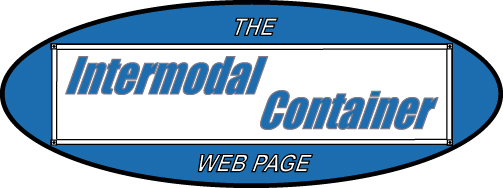

Background Information on Non-Standard Containers by Matt Hannes
The Early Days
The years before the ISO set standard sizes were more or less a "free-for-all" for container dimensions. Different steamship lines picked different sizes based on what worked best for them. At that time nobody envisioned just how widespread containerized freight transportation would become, and as a result few companies considered interchangability. To name a few examples: Sea-Land used 35' containers, SeaTrain used 27' containers, Matson used 24' containers, etc. Other shippers used 8', 12', and 15' containers in small numbers.
When the ISO set world standard container sizes in the mid-1960s, many companies found themselves with fleets of non-standard containers. They dealt with this dilemma in various ways. For example, since Matson operates a closed route (that is, one without much interchange with other shippers), it chose to disregard the standard and continues to use 24' containers today. SeaTrain eventually converted to ISO standards, as did Sea-Land, although the latter's fleet would not be fully standardized until the mid-1980s.
The American railroads also experimented with a variety of domestic container operations in the 1950s and 1960s. The western railroads owned small fleets of 24' containers in the 1960s for compatibility with Matson's operations. The eastern railroads were also developing their own container systems. A good example of this was New York Central's ambitious Flexi-Van service which used fleets of spine cars (ahead of their time) and various sizes of containers. B&O, Southern, and others also had small container operations. During the 1970s most of these operations were abandoned due to competition from the domestic trucking industry. Unfortunately I don't have photos of any of these containers here. A great reference for this topic is David J. DeBoer's book Piggyback and Containers: A History Of Rail Intermodal on America's Steel Highway published in 1992 by Golden West Books.
Some readers may also recall the U.S. Navy's Container Express ("Conex") system used extensively in the military operations in Korea and Vietnam. They were 6x6x6' in size and used the basic principles of containerization to maximize efficiency. Many shipping companies were using fleets of Conex boxes at the dawn of containerization in the early 1960s. By the late 1960s they were phased out in favor of the larger 20x8x8.5' sea containers.
Development of Standard Sizes
The International Standards Organization (ISO) set container dimension standards in the mid-1960s. These standards allowed for containers with lengths of 10, 20, 30, or 40 feet. Width was fixed at 8'-0" and height was 8'-6". The 10' and 30' containers never caught on, and few were ever used in international service. Hence the reason why I have included these containers in the Non-Standard section of the web site. Later on, "high-cube" containers became a standard with 9'-6" height. Some small groups of 9'-0" tall containers were also used during the 1970s and 1980s. In the early 1980s, APL introduced the 45' high-cube container, which also became an international standard container.
Domestic Containers
In 1985 APL introduced the 48' container, followed by the 53' container in 1988. These sizes were created to better compete with the American trucking industry which was switching from 40' and 45' trailers to 48' and 53' trailers. In addition to being longer than the ISO boxes, the American domestic containers were 8'-6" wide (including some domestic 45's). The 48' and 53' containers proved to be too big for most other countries to handle, so they never became a worldwide standard. Due to the large variety of American domestic containers, I have dedicated an entire web site to them (Part 3) so they are not covered in this section of the web site.
The United States was not the only country developing domestic containers. Europe and Australia have domestic containers which do not travel outside their respective home continents. Europe's domestic containers vary in sizes - some follow the ISO lengths but others have metric lengths of 7.15m, 7.45m and 13.6m to name a few. European containers are usually wider than 8'-0" to accomodate European pallets. Containers with 2.5m and 2.55m widths are commonly used in Europe. Australia uses variations of the 48' and 53' sizes similar to their U.S counterparts.
So if you thought all containers were 20' and 40' long, well, you have a lot to learn! Browse the photo galleries in Part 4 and enjoy the diversity of the world container scene.
Copyright 2004-2007 The Intermodal Container Web Page.
Thanks for visiting. Contact me.